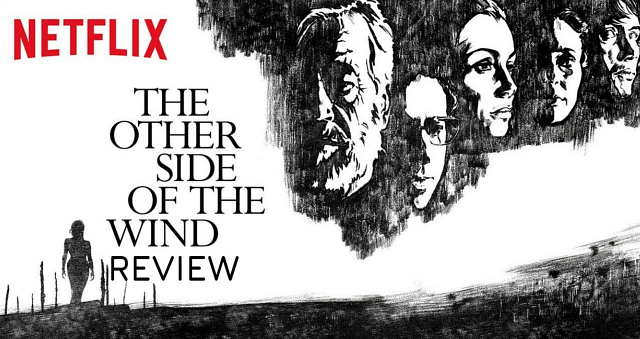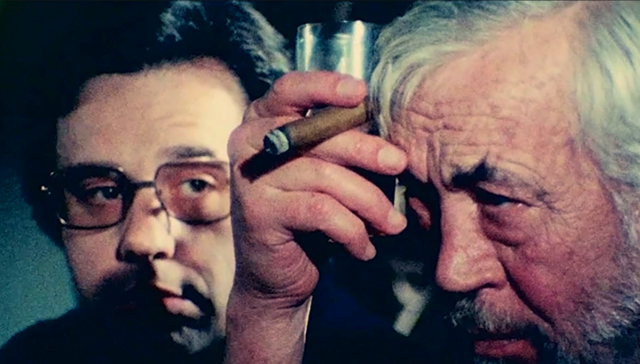Six months ago I posted a strongly negative reaction to Orson Welles‘ The Other Side of the Wind. It was still a hot, unseen item at the time (except for those who’d seen it in Venice, Telluride and Toronto) and so HE commenters had little to say beyond (a) “we love Orson and Wells is therefore a jerk”, (b) “Wells has a general animus toward large, round objects” and so on.
One HE commenter who’d seen it, Rosso Veneziano, pretty much agreed with me: “I didn’t understand a damn thing about it. What was the point? What was happening? I was somehow fascinated, the audience laughed at the beginning here and there, but the more it went on the more it was unbearable. It’s a memory movie, it has its place in a museum like an art installation you watch for 15-20 minutes during your Welles tour. But the big screen doesn’t do it any favor.”
The Other Side of the Wind began streaming on Netflix on 11.2, or over three months ago. Surely everyone has had a looksee by now. Please fire away, no holding back.
Posted on 9.19.18: “The Other Side of the Wind is a bitter, cynical, sometimes darkly funny hodgepodge, an inside-new-Hollywood movie that was filmed on the fly between 1970 and ’75 in various formats, and a film that has a lot on its mind but has crawled so far up its own ass that the viewer can’t hope to enjoy much access.
“It’s not a good film. Any film that makes you say ‘wait…what’s happening?’ or ‘what was that line?’ over and over is doing something wrong. It’s so damn spotty and splotchy. So scatter-gun, so haphazardly chop-chop and cut-cut. It never achieves a rhythm or a sense of flow-through or harmony of any kind. Within 10 or 15 minutes I was feeling exhausted.
“It’s about an old craggy director named Jake Hannafort (John Huston) who sees himself as cut from the Ernest Hemingway cloth, and who’s just back from Europe and trying to find money to finish a film or start a new one or something along these lines. And so he throws a party in the desert and dozens attend — rivals, colleagues, managers, film critics, sycophants, students with cameras, wannabes, old friends.
“Nobody ever seems to actually converse in an engaging, back-and-forth way. Nobody seems to listen to anyone else. It’s all bitter talk, fuck talk, belch…bitter talk, fuck talk, belch…bitter talk, fuck talk, belch…bitter talk, fuck talk, belch…bitter talk, fuck talk, belch, etc.

“It would be one thing if everyone was improvising and Welles was gradually threading their material into some kind of half-assed narrative that delivered some kind of attitude or metaphorical mood, but everyone (and I mean especially the name-brand actors) is (a) “acting” and (b) obviously “speaking lines,” and it just doesn’t work.
“Withered, craggy-faced Huston keeps puffing away on that cigar and regarding everyone with suspicion or disdain or a combination of both. Lili Palmer (a replacement for Marlene Dietrich) just sits around and says her lines in a deadpan way. Chubby-faced Peter Bogdanovich (playing a hot young director named Brooks Otterlake) says his lines with a tone of wry self-amusement. Susan Strasberg (a Pauline Kael stand-in) says her lines in a kind of needling, challenging way. Cameron Mitchell just hangs around and says his lines; ditto puffy-faced Edmond O’Brien. Paul Stewart says his lines in the usual Stewart way…seen it all, heard it all. Joe McBride says his lines with a certain sardonic edge. But I couldn’t latch onto anything or anyone. The film refuses to sink in.
“Where is this going? What is there to learn or care about? Where is the soul of this film? Who wants to wade through this fucking mess of a movie? This is so inside-baseball I’m getting a headache.
“Nothing really happens except that (a) everyone on the studio lot is invited to Jake’s party in the desert, (b) everyone arrives at the desert-house party and starts making sage, cutting remarks about this, that or another thing…yap-yappity-yap-yappity-yap-yap, (c) everyone becomes more and more drunk and cynical and despairing, (d) everyone heads for an outdoor drive-in to watch Jake’s movie, and then (e) Jake drives off in a Porsche and dies. (Except he does this at the very beginning, or before the beginning)
“Robert Altman used to be so much better at this kind of thing — he would capture little snips and quips and cut away to this or that and somehow it would all fit together, but Orson’s film is so fucking “written out” and everyone is so determined to “act” (i.e., sell the moment, charm the audience) as well as radiate cynical or bitter or burnt-out or testy or pissed-off attitudes or feelings.
“Does anyone in this film care about anything or anyone? I didn’t give a fuck about anyone or anything. At all. It really, really doesn’t work.

“My guess is that Orson saw an opening in the late ’60s atmosphere of freedom and experimentation in Hollywood, and he figured he could catch a ride upon that. He felt he had to assemble something loose and choppy and catch-as-catch-can and dreamscapey because he didn’t want to be the old guy making movies in a traditional way, and so he wrote a script about a cigar-smoking filmmaker like himself, looking for money to make or finish a film, and involved in a sexual relationship with a much younger person (Oja Kodar in Orson’s case, Bob Random‘s “John Dale” in Jake Hannaford’s case) and just winging it.
“Orson half-admits to the audience that he’s just fucking around as best he can when an older sycophant guy tells a dark-haired producer-or-agent guy that there’s really no script, and the producer-or-agent guy walks out and says ‘tell Jake he’s just wasted my time.’
“The only scene that I really was into (and that wasn’t pissing me off) was the sex scene between Random and Oja, in the front seat of a car driving through a rainstorm. It’s actually mildly hot. Orson, it seems, was apparently swooning with desire for Oja back then and Oja loved the attention, but his decision not to give her any lines wasn’t very considerate. He basically makes her into a kind of default lust object. After a while you start assuming that all she knows how to do is take her clothes off. After a while you start asking yourself if she’s capable of anything except walking around bare-assed. Did she have an impossible accent at the time? Is that why Orson didn’t give her any lines? She’s supposed to be a Native American so she wears dark brown makeup and eyebrow pencil and whatnot. It looks fake and weird.
“I had two solid thoughts or notions in my head when it ended. One was ‘wow, Orson was certainly having it off with a really beautiful woman back then, and she really knew how to breathe and pant and undulate her stomach muscles like a belly dancer and really throw it to her sexual partner of the moment.’ The other was ‘well, that didn’t work…it’s just a portrait of a somewhat elderly filmmaker who doesn’t have much of an idea about what he’s about or what he wants to say or how to go about it, and so he’s just throwing lettuce leaves into the air and figuring ‘fuck it, maybe I can make something out of this in the editing room.'”
I’ve actually absorbed a third thought, which is that it must have been a whole lot of fun to have been part of the Other Side of the Wind shoot back in ’70, ’71 and ’72. Hugely enjoyable for those who were there and sharing a magic moment, but not much fun for those watching the finished product in 2018. Okay, it’s diverting here and there.













